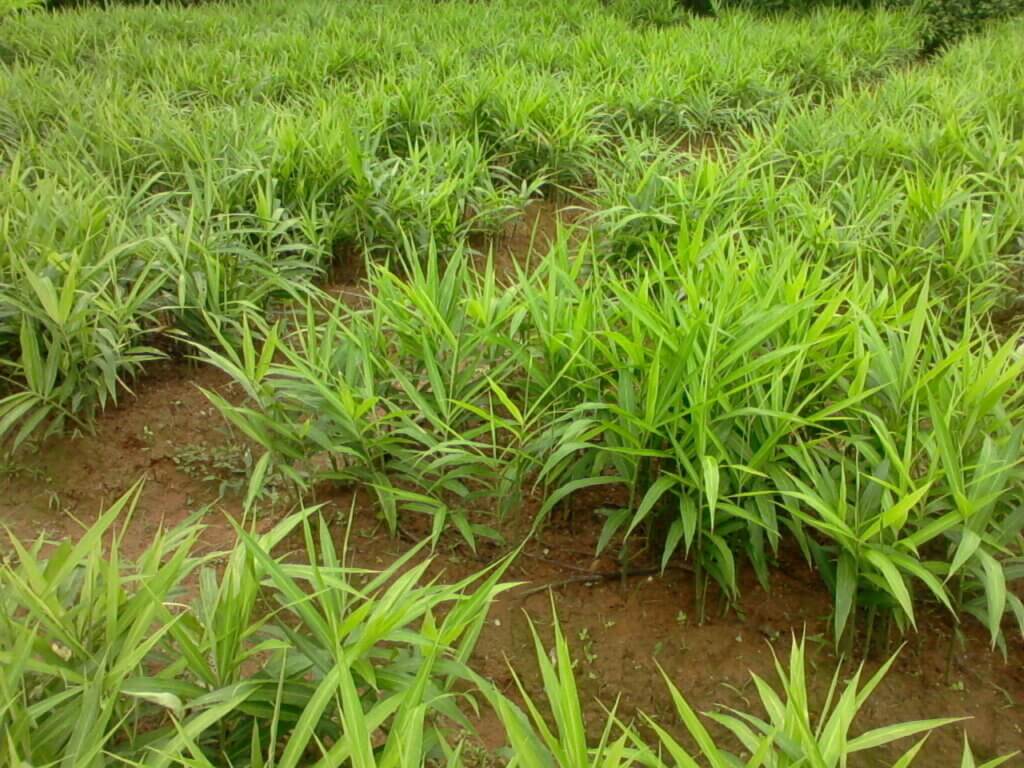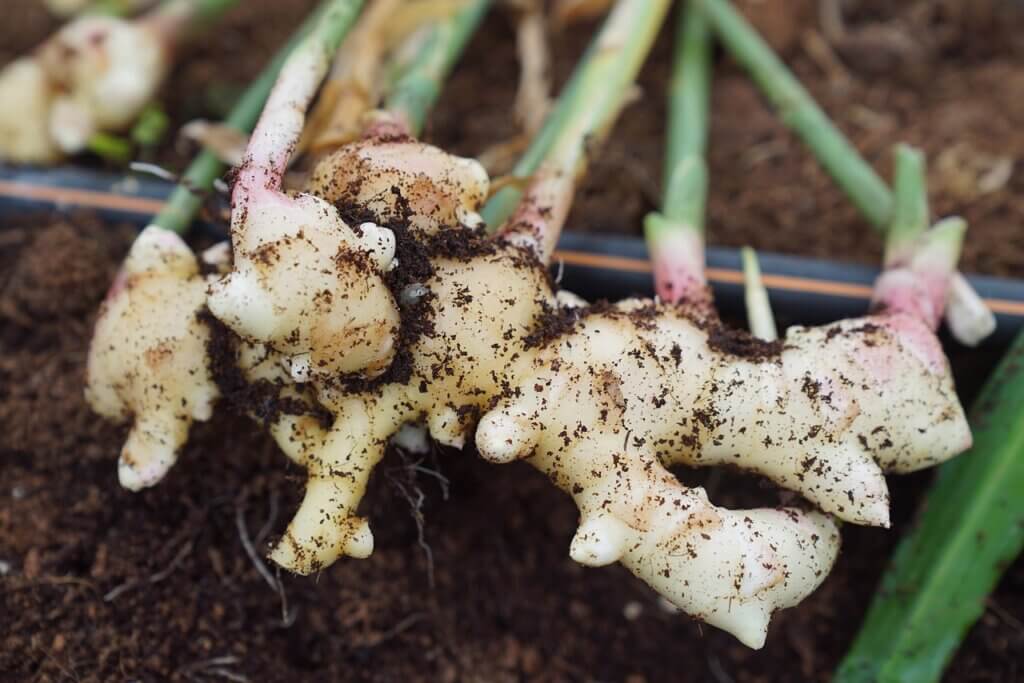Ginger or Zingiber officinale is known for its pungent, aromatic, and edible spicy rhizomes. The rhizomes are mostly referred to as the ginger roots. The major components in ginger are called gingerols, responsible for its unique flavor and fragrance.
Gingerols are strong anti-inflammatory compounds that help to minimise arthritis pain. Going by the scientific studies, ginger boosts immunity, induces cell death in ovarian cancer, and offers protection against colorectal cancer.
Talking about the texture of these rhizomes, it is knotty, firm, striated, and rough. Based on the different varieties, the flesh inside can be white, yellow, or red. The skin of ginger differs from cream to light brown and maybe thin or thick, based on its maturity when harvested.
Why are we telling you all these things about ginger? Well, it is because we will talk about how to grow ginger. It is an important ingredient in Asian homes, and over the years, with evolving gardening tools and techniques, people across the world like in the United States are also seeking to grow the plant on their own.
The good news is you can grow ginger roots at home, regardless of your location. This may sound like a vague statement now, but when the right ways are followed, it is possible to grow ginger in both hot and cold climates.

How to grow ginger?
Today, we will discuss how to plant and care for the ginger plant. Our next blog on ginger will be about growing ginger in colder climates.
Let’s get started.
Planting ginger
Choose early spring to start
Being a tropical plant, ginger fails to survive frost. So, it is advised that you plant the rhizome post last spring frost. If you live in tropical regions, you can also start when the wet season starts. For people who live in an area with a climate that allows short growing season, growing ginger indoors is a better option.
Choose the ginger plant
While deciding about the ginger plant, you will come across various species, of which the most edible variety is Zingiber Officinale. To grow this species, you only need to get ginger root from the nearest grocery store.
You should choose ginger roots that are free of wrinkles and plump, with protruding eyes (small buds) at the end of “fingers”, If the buds are green, it is ideal. However, it is not necessary to find green ones.
You can also buy organic ginger if possible. Some non-organic ginger is treated with a growth inhibitor. Some experienced gardeners suggest soaking the inhibited ginger (or non-organic ginger) in warm water overnight. It helps in the stimulation of the inhibited ginger roots.
In this blog, we have covered Zingiber Officinale.
Cut the rhizome
When you plan to grow multiple ginger plants, cut the ginger into pieces using sanitized shears or knife.
The pieces you cut should be of at least 1 inch wide in size with at least one bud/eye.
Allow the pieces to heal for a few days in a cool and dry place.
Over a few days, they will develop a protective callus covering the cut surface. It reduces the chances of any infection.
When planting multiple pieces of ginger/rhizomes, make sure there’s a minimum of 8 inches space between each piece.
To increase the chances of sprouting, take a piece with three or more buds.
Make the soil
Ginger grows well in well-draining, high-quality soil. To prepare the optimum quality soil for planting the rhizomes, mix garden soil with well-rotted compost, both in equal proportion.
In case your garden soil is heavy in clay or poor quality, you can always go with the potting soil from a nursery.
To keep a check on the ginger, you can use a starting tray, to begin with. Fill the tray with coconut fiber or sphagnum moss. These elements are well-draining and prevent the chances of rot in young plants.
Soon after roots and leaves form, you must transplant the ginger to the soil. This can be a traumatic change for your plant. The suitable temperature for the ginger to sprout is around 70-degree Fahrenheit. You may need to get a heat mat or any heat source to maintain the ideal temperature of the soil.
Ginger demands mildly acidic soils for proper growth. So, if your garden has alkaline soil, you need to use a garden store kit for adjusting it to a range of 6.1 to 6.5 pH.

Choose an ideal location
A ginger plant requires partial shades to thrive. Locations that experience only the morning sun also make for an ideal planting site for ginger. However, make sure it is at a distance from large roots. The site should be protected from wind and moist. But, it shouldn’t be swampy.
In case your ginger plant is not germinated, you must ensure the temperatures of the soil remains warm – somewhere between 71 to 77 degrees Fahrenheit.
If you are growing the ginger in pots, select one with a depth of 12 inches. We would suggest going for a plastic pot over terra cotta. Nevertheless, several drainage holes at the bottom is a noted concern.
In the tropical region, the rhizomes can grow in complete shade. But for places slightly colder, look for sites that experience 2-5 hours of direct sunlight in a day.
Plant the ginger
So, now your soil and location (or pot) are ready. It’s time to plant the pieces of ginger. Place the pieces 2-4 inches under loose soil. Make sure the buds/eyes face upward.
When you are planting in rows, maintain a distance of 8 inches between each piece. In case of the ones to be planted in pots, plant a single piece in one large container or pot.
Harvesting ginger
Hold the leaves of the ginger plant from the base – the point from where it emerges and pull the rhizome completely.
Tear away a chunk of the rhizome (as needed) and place the rest back in the pot or planting site.
Sprinkle compost or potting soil to cover it, and water well.
Treat the plant gently for a few days like you would do after transplanting it into the garden.
Protect it from direct sunlight for a few days.
Taking care of the ginger plant
You read about planting and harvesting your ginger plant but what comes in between these two process – taking care of your ginger plant.

Make sure you do not neglect the growth phase after planting the rhizome. Check out what to do and what not to do:
Keep the soil wet/damp
Right after planting your ginger/rhizome, water it gently. Keep an eye on the soil and water when it is about to dry out. Keeping the soil damp doesn’t mean you need to make it soggy – that will rot the roots. You need to check for proper drainage or reduce watering if the soil gets excessively wet.
Keep your eyes open for germination
As you know by now, ginger is a slow-growing plant, mainly when grown away from the tropics. You may notice a sprout in a few days if luck favors, but you should keep watering the plant for at least two weeks. After germination, continue with the regular watering schedule.
Fertilize the plant every month
When you plant ginger in high-quality soil, you need not fertilize the plant. If you have mixed the soil with compost, fertilization becomes optional. So, you should test the soil before deciding on fertilizing it.
In the case of poor soil, it is crucial to improve the yield using a liquid fertiliser every month.
Mulch outdoor ginger
Another optional activity, while the ginger grows, is to mulch the rhizome planted outdoors. Soon after the ginger is sprouted, mulching will ensure it’s warm and fights back weed.
Spread a thick layer of mulch as soon as you notice the temperature of soil falling to 50ºF or below in the growing season.
Let the soil dry when the stems die
In late summer or on the onset of fall, the stems of ginger changes to yellow because of the drop in temperature. When this happens, minimize watering the plant and stop it as soon as the stem dies. You might not see the ginger plant flowering the first year of its plantation in a short growing short.
Allow the plant to mature before harvest
On allowing ginger to grow in the ground, it develops a more powerful flavor. Eight months after planting ginger and after the stem dies out, dig up the rhizome. You can cut some pieces off. It won’t kill your plant until you keep leaving some eyes/buds behind.
You can harvest young ginger after 3-4 months. However, be careful with the thin skin while harvesting. Always use a sanitized shear or knife to cut the plant.
Get ready to grow ginger in your garden
You can now successfully grow ginger on your own by following these easy but careful steps. Take care of your ginger plant throughout the growing season and harvest it as need after 3-4 months of planting.
If you have any queries about how to grow ginger, let us know in the comments.
You may also like to read
How to Grow Cardamom? – Everything From Propagation to Harvest and Storage






